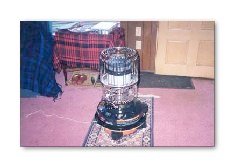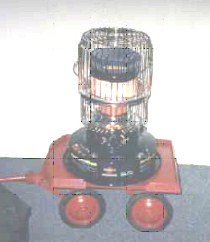Consumer Product Safety Commission
CPSC and NKHA Stress Kerosene Heater Safety
CPSC Document #5052
https://www.cpsc.gov/s3fs-public/5052.pdf
If you are using a kerosene heater, the U.S. Consumer Product Safety Commission and the National Kerosene Heater Association advise you to follow these suggestions in order to minimize the risk of fire and potential health effects from indoor air pollution.
Use only water-clear 1 K grade kerosene. Never use gasoline. Gasoline is not the same as kerosene. Even small amounts of gasoline or other volatile fuels or solvents mixed with kerosene can substantially increase the risk of a fire or an explosion.
Always store kerosene in a separate container intended for kerosene, not in a gasoline can or a can that has contained gasoline. This helps you avoid using contaminated fuel or the wrong fuel by mistake. Kerosene containers are usually blue; gasoline containers are usually red.
When purchasing kerosene at the pump, make sure to use the kerosene pump, not the gasoline pump. Some service stations have separate islands for kerosene. Some oil companies have also established quality control programs to minimize the chances of gasoline contamination of kerosene.
1-K grade kerosene should be purchased from a dealer who can certify that what is being sold is 1-K. State operated and private sector certification programs that ensure the quality of kerosene are established in some states. Grades other than 1-K can lead to a release of more pollutants in your home, posing a possible health risk. Different grades of kerosene can look the same so it is important that the dealer certify that the product sold is 1-K grade kerosene.
Never refuel the heater inside the home. Fill the tank outdoors, away from combustible materials, and only after the heater has been turned off and allowed to cool down. Do not refuel the heater when it is hot or is in operation. Do not fill the fuel tank above the "full" mark. The space above the "full" mark is to allow the fuel room to expand without causing leakage when the heater is operating.
In case of flare-up or if uncontrolled flaming occurs, do not attempt to move or carry the heater. This can make the fire worse. If the heater is equipped with a manual shut-off switch, activate the switch to turn off the heater. If this does not extinguish the fire, leave the house immediately and call the fire department. As an added reminder and precaution, install at least one smoke detector near each sleeping area or on each level of the house.
Reduce your exposure to indoor air pollutants by properly operating and maintaining your portable kerosene heater. Although portable kerosene heaters are very efficient in the burning of fuel to produce heat, low levels of certain pollutants such as carbon monoxide and nitrogen dioxide are produced. Exposure to low levels of these pollutants may be harmful, especially to individuals with chronic respiratory or circulatory health problems. To assure that you and family members are not exposed to significant levels of these pollutants, you should follow carefully the following rules of safe operation:
Operate your heater in a room with a door open to the rest of the house.
If you must operate your heater in a room with the door closed to the rest of the house, open an outside window approximately an inch to permit fresh air to effectively dilute the pollutants below a level of concern.
- Always operate your heater according to the manufacturer's instructions, making sure that the wick is set at the proper level as instructed by your manufacturer.
Keep the wick in your heater clean and in good operating condition by following the cleaning and maintenance procedures recommended by the manufacturer.
Keep an outside window opened approximately an inch to insure adequate fresh air infiltration. This is true regardless of whether you use a kerosene heater or some other conventional method of heating, if your home is relatively new and tight, or if it is older but has been winterized to reduce air infiltration from the outside.
! DANGER: Risk of explosion. Never use gasoline in this heater.
! CAUTION: Risk of indoor air pollution. Use this heater only in a well ventilated area. See operating instructions for details. 009403.
U.S. Govt Printing Office: 1996 - 402-314/39054
---
Send the link for this page to a friend! Consumers can obtain this publication and additional publication information from the Publications section of CPSC's web site or by sending your publication request to info@cpsc.gov.
This document is in the public domain. It may be reproduced without change in part or whole by an individual or organization without permission. If it is reproduced, however, the Commission would appreciate knowing how it is used. Write the U.S. Consumer Product Safety Commission, Office of Information and Public Affairs, 4330 East West Highway, Bethesda, MD 20814 or send an e-mail to info@cpsc.gov.
The U.S. Consumer Product Safety Commission is charged with protecting the public from unreasonable risks of serious injury or death from more than 15,000 types of consumer products under the agency's jurisdiction. Deaths, injuries and property damage from consumer product incidents cost the nation more than $700 billion annually. The CPSC is committed to protecting consumers and families from products that pose a fire, electrical, chemical, or mechanical hazard or can injure children. The CPSC's work to ensure the safety of consumer products - such as toys, cribs, power tools, cigarette lighters, and household chemicals - contributed significantly to the 30 percent decline in the rate of deaths and injuries associated with consumer products over the past 30 years.
To report a dangerous product or a product-related injury, call CPSC's hotline at (800) 638-2772 or CPSC's teletypewriter at (800) 638-8270, or visit CPSC's web site at http://www.cpsc.gov/talk.html. To join a CPSC email subscription list, please go to http://www.cpsc.gov/cpsclist.asp. Consumers can obtain this release and recall information at CPSC's Web site at http://www.cpsc.gov.

 By Miles Stair
By Miles Stair Kerosene heaters are relatively heavy, and they do need to be moved around. It's safer to fuel them on a patio, for example. When burning the wick dry, again the heater should be moved outdoors to a covered area that is not drafty, as that process produces fumes. Sometimes the heater needs to be moved from one room to another. Why carry the heater when a cart can be easily built ...
Kerosene heaters are relatively heavy, and they do need to be moved around. It's safer to fuel them on a patio, for example. When burning the wick dry, again the heater should be moved outdoors to a covered area that is not drafty, as that process produces fumes. Sometimes the heater needs to be moved from one room to another. Why carry the heater when a cart can be easily built ...